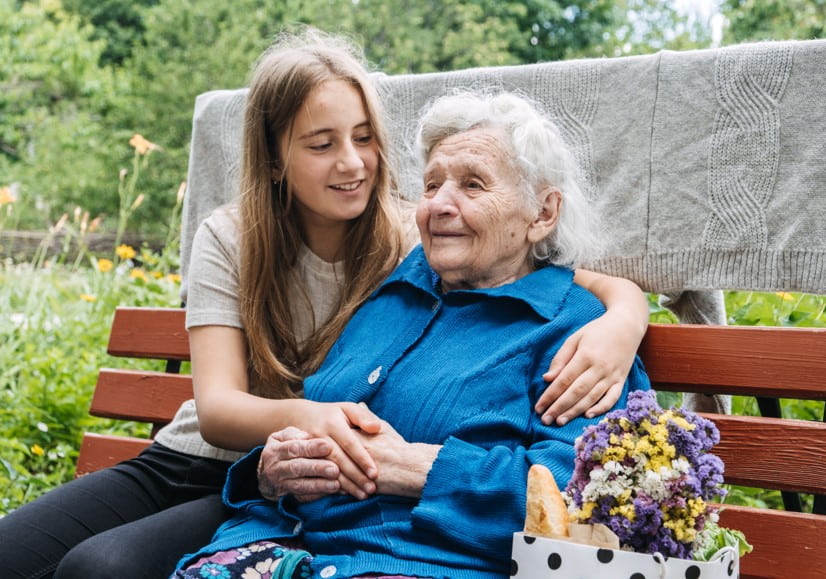In Something Wicked This Way Comes, Ray Bradbury captured the quiet strangeness that arrives when autumn fades. The air cools, the light changes, and everything feels slower, softer, more inward. November has that kind of stillness, the kind that invites reflection but can also make the heart feel heavy.
For many older adults, that shift is more than a mood. Colder temperatures, less sunlight, and changes in daily rhythm can all affect how they think and feel. Some become quieter, some lose interest in small joys, others simply seem different like the spark that usually fills the room has dimmed a little.
If you’re close to someone in this stage of life, it’s worth asking yourself:
- Have they stopped doing the little things that once made them happy?
- Do they seem less engaged in conversations or visits?
- Are they sleeping or eating differently than before?
- Have they begun to decline invitations or social activities they used to enjoy?
- Do they smile, but with less light behind it?
Recognizing emotional changes in seniors during winter isn’t about worrying, it’s about noticing. These gentle questions can help families spot early signs of sadness or withdrawal before they deepen.
In the following sections, we’ll look at what these changes might mean, how the season influences mood and motivation, and what families can do to help bring warmth back into the cold months.

Recognizing Early Emotional Changes in Seniors
To recognize those early shifts, it helps to pay attention to the texture of everyday life. The following signs don’t always mean something serious, yet they deserve attention because they reveal how the inner world of an older adult responds to the outer season.
When Familiar Rituals Begin to Fade
Every person has small daily ceremonies; folding a napkin just so, checking the window view before breakfast, adjusting a radio dial. When these disappear, the change can seem trivial. In reality, it may reflect a quiet retreat from engagement.
Instead of asking why they stopped, join the moment: “Would you like to check the garden together?”
Emotional connection often returns through participation, not interrogation.
The Subtle Language of Withdrawal
Isolation doesn’t always look like being alone. Sometimes it sounds like politeness. “I’m fine,” “Don’t worry about me,” “You’re busy.” These phrases protect dignity, yet they also build distance.
Try gentle conversation starters that invite stories instead of answers:
- “Who did you talk to this week?”
- “What memory came to mind today?”
Stories rekindle agency. They remind people that they still have something to tell, and someone ready to listen.
Fatigue Beyond the Body
Winter shortens the days, and the mind can follow. Many older adults describe a strange tiredness, less about sleep, more about motivation. It’s the weight of hours that feel too quiet.
Notice when naps multiply or movement slows. Natural light can make a remarkable difference, as can shared activity: folding laundry together, stretching while music plays, preparing breakfast side by side. The goal isn’t productivity; it’s reawakening rhythm.
Appetite as a Barometer of Spirit
Families often focus on what their loved ones eat, not how they approach food. A loss of appetite can reflect more than taste; it may mirror emotional dullness. The same happens with hobbies: books left halfway, music left unplayed.
Pleasure fades gently, not dramatically. You can invite it back by creating micro-moments of joy: warm cocoa after a walk, a familiar record before dinner, a candle lit at dusk. These sensory cues help the brain rediscover vitality.
The Shift in Narrative Tone
Listen not only to what is said, but to how it’s said. When stories shrink into single sentences, when opinions turn to indifference, when laughter becomes a quiet smile, emotional energy may be waning.
Language is a mirror of the inner world. Encourage your loved one to recall feelings rather than facts; what made them proud, or surprised, or grateful. Emotions awaken memory more effectively than questions about dates or details.
The art lies in noticing what others overlook: the silence between songs, the plate left untouched, the conversation that ends too soon. Each of those gestures is a small letter from the heart, waiting for someone patient enough to read it.
How Winter Affects Seniors’ Mood and Motivation
Imagine you wake up and the sunlight feels weaker, almost shy. The clock says morning, but your body insists it’s still night. This confusion isn’t laziness; it’s biology playing tricks. The human brain is guided by light, and winter quietly rewrites that script.
When daylight shrinks, the brain releases less serotonin, the neurotransmitter linked to mood, focus, and energy. At the same time, it increases melatonin, which prepares the body for rest. It’s as if nature itself whispers: slow down, hibernate, disappear for a while.
But humans don’t hibernate. We keep moving and for many seniors, that tension between biology and routine creates emotional turbulence.
The Science Behind the “Winter Mood”
Psychiatrist Dr. James Cartwright, who specializes in geriatric mental health, explains it simply:
“Older adults experience light more intensely because their eyes let in less of it. What feels like a cloudy day to you may feel like twilight to them.”
That means the emotional landscape of winter is physically darker for seniors. Vision changes with age, and the retina sends weaker signals to the suprachiasmatic nucleus—the brain’s master clock (Rosen et al., 2021).
Result: sleep patterns shift, appetite changes, and motivation fades, not by choice but by chemistry.
A Hidden Emotional Geography
Think of the brain as a country with seasons of its own. In summer, its cities are awake and connected. In winter, some roads close temporarily.
The prefrontal cortex—responsible for decision-making and curiosity—works best under daylight. When that stimulus fades, the limbic system (where emotions live) takes a stronger lead.
That’s why many older adults describe winter as “foggy,” “heavy,” or “quiet.” The brain literally reallocates resources, focusing on maintenance instead of exploration.
Gerontologist Dr. Elena Márquez, who studies motivation in aging populations, describes this shift poetically:
“Winter lowers the volume of the world. Those who learned to dance with silence adapt. Those who resist it often feel lonely, even when surrounded.”

The Psychology of Color and Movement
Here’s a curious detail: researchers have found that color perception also changes slightly in winter. Cooler tones dominate our visual field, and this can subtly influence mood (Küller et al., 2009).
That’s why warm surroundings—soft amber lights, colored scarves, candles, or even orange fruit—help lift spirits. They literally feed the optic nerve with energy that feels alive.
Similarly, gentle movement helps the body “speak back” to the brain. When a senior takes a morning walk, stretches while music plays, or waters plants by the window, the body sends signals that reset the circadian rhythm.
It’s not about exercise; it’s about reactivating the conversation between biology and daylight.
A Simple Thought Experiment
Next time you visit an older loved one, look around and ask yourself:
- How much sunlight touches their favorite chair?
- What sounds fill the house before noon?
- Do the colors of the room invite wakefulness or rest?
These small environmental details shape emotional architecture. A lamp in the right place can shift a mood more effectively than a motivational speech.
Supporting a Loved One Through Seasonal Depression
Start with Light—Real or Borrowed
Light is a biological rhythm, not decoration.
When it fades, the brain forgets how to keep time.
Here’s what helps:
🪟 Morning window therapy: Breakfast near sunlight or a bright window. The body registers brightness as optimism.
💡 Soft lamp strategy: Use warm daylight bulbs near reading spots or favorite chairs.
🕰️ Consistency: Try to keep the same waking and sleeping times. Predictability calms the mind.
“Light is an antidepressant you don’t have to swallow,” says geriatric psychiatrist Dr. Irene Goldstein. “Older adults don’t just need light; they need rhythm.”
The Sensory Reboot
When emotions flatten, the senses are the first to fall asleep. You can wake them gently:
- Taste: Cook something aromatic. Cinnamon, lemon, or roasted garlic revive more than appetite—they awaken memory.
- Sound: Replace background TV with music that carries emotion—jazz, boleros, folk songs from their youth.
- Touch: Encourage small tactile comforts: a favorite sweater, warm blankets, hand creams with scent.
- Sight: Use color contrast—deep greens, amber lights, blue accents. Color therapy isn’t aesthetic; it’s neurological stimulation.
💭 Ask yourself: What does this space make someone feel?
Questions That Reconnect
Conversations don’t heal depression, but they open the door.
Choose questions that don’t demand answers but invite reflection:
- “What’s a winter you remember fondly?”
- “Who used to make you laugh when it was cold outside?”
- “What’s your comfort food when you’re feeling quiet?”
- “Would you like to play that old record again?”
Every story told releases oxytocin. That’s the chemistry of connection, not small talk.
Micro-Moments of Purpose
Forget big goals. The brain under seasonal depression needs structure, not pressure.
Here’s a small list that often helps:
✅ Watering a plant each morning
✅ Feeding a pet
✅ Writing a line in a journal
✅ Making tea for someone else
✅ Watching the same show at the same hour
These micro-actions build momentum. Purpose doesn’t arrive—it accumulates.
How Senior Living Transforms the Season
Communities built for older adults often function like emotional ecosystems.
They synchronize human rhythm with environmental rhythm: bright spaces at breakfast, social activity midmorning, soft lighting at dusk.
Within these spaces, depression loses its camouflage. Staff are trained to spot changes early, while peers naturally create daily connection—someone to sit beside, someone who remembers your favorite dessert, someone who says good morning at the right time.
Senior living doesn’t replace family—it extends family structure into daily life.
In winter, that can be the difference between endurance and well-being.
🌙 Ask Yourself Tonight
Before the day ends, take a quiet moment and reflect:
- Did my loved one laugh today, even once?
- Did they see the sky, or just the ceiling?
- Did they choose something—a song, a meal, a thought—for themselves?
If the answer to any of these is yes, connection is happening.
That’s where recovery begins: in the smallest sparks that remind us the world is still alive and waiting to be felt.
References
Rosen, L. N., Targum, S. D., Terman, M., Bryant, M. J., Hoffman, H., Kasper, S. F., & Wehr, T. A. (2021). Circadian rhythm abnormalities in seasonal affective disorder. Journal of Affective Disorders, 294(1), 128–136.
Küller, R., Ballal, S., Laike, T., Mikellides, B., & Tonello, G. (2009). The impact of light and color on psychological mood: A cross-cultural study. Ergonomics, 49(14), 1496–1507.




